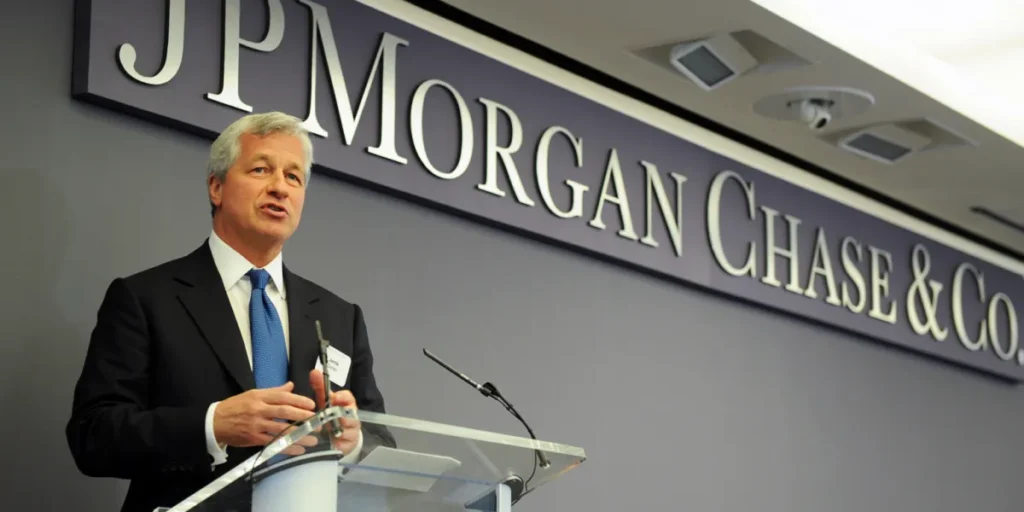JP Morgan Chase, the largest bank in the United States, has reported strong second-quarter results, defying expectations and showcasing its financial resilience in a period filled with economic uncertainty. While major banks have been treading cautiously amid concerns about inflation, interest rate fluctuations, and global political instability, JP Morgan has surged ahead, reflecting both its vast financial foundation and strategic adaptability.
The bank posted impressive revenue and profit figures, driven by robust consumer activity, higher interest income, and strength in its corporate and investment banking segments. Despite the strong showing, CEO Jamie Dimon took a cautious tone, warning that clouds still loom on the global horizon.
Dimon Celebrates Wins, But Urges Caution
In his typical straightforward style, Jamie Dimon acknowledged the company’s success but stressed that the road ahead might be rocky. While applauding the bank’s operational discipline and broad-based growth, Dimon voiced concerns over rising tariffs, geopolitical tensions, and uncertain regulatory environments across major global economies.
He pointed to the unpredictable nature of ongoing trade disputes, the war in Ukraine, and increasing instability in parts of Asia and the Middle East as potential disruptors. “We’re doing well now,” Dimon said, “but we have to be prepared for anything.”
Interest Rates and Lending Boom
One of the key factors contributing to JP Morgan’s second-quarter success was the bank’s ability to benefit from higher interest rates. With the Federal Reserve maintaining elevated rates to combat inflation, JP Morgan saw a boost in net interest income — the profit it earns from lending money versus what it pays on deposits.
Retail banking remained solid, with consumers continuing to spend and borrow, even amid fears of economic slowdown. Credit card activity surged, and home lending stayed relatively steady. These trends helped offset weaknesses in areas like investment banking, which has faced headwinds due to fewer mergers and acquisitions.

Corporate Clients Return With Confidence
Corporate banking showed encouraging signs of recovery. While the deal-making environment remains softer than during the post-COVID boom, many corporate clients have resumed activity, including refinancing and strategic restructuring. Large firms are once again seeking advice and credit facilities from major banks, and JP Morgan remains a top choice due to its broad capabilities and global reach.
Corporate deposits stayed strong, and businesses have begun cautiously expanding, signaling a return of confidence despite global uncertainties. The bank’s ability to serve multinational clients across industries and continents gives it a major edge.
Trading and Investment Division Holds Firm
JP Morgan’s trading division, although not at its pandemic-era highs, posted better-than-expected results. Markets have remained volatile, but that has provided opportunities for gains — especially in fixed income trading and derivatives. The equities division held steady, supported by cautious but active investors repositioning portfolios in a complex interest rate environment.
While some Wall Street competitors struggled to match expectations, JP Morgan’s deep talent pool and technology-driven systems enabled it to outperform in this area once again.
Expense Management and Cost Control
One of the more understated strengths in JP Morgan’s Q2 performance was its ability to manage costs while growing its business. Expenses rose slightly due to wage increases and continued investment in digital infrastructure, but these were offset by higher income and improved operational efficiencies.
Technology remains a major focus for the bank, with ongoing investments in artificial intelligence, cybersecurity, and digital banking platforms. Dimon reiterated the bank’s commitment to innovation, calling it “not a choice, but a necessity in the current environment.”

A Cautious Outlook Despite Strong Fundamentals
Despite the glowing results, JP Morgan is not getting complacent. The bank has built reserves for potential loan losses, especially in commercial real estate and other sectors that might come under stress if interest rates stay high for longer.
Dimon emphasized the importance of staying alert to global risks. Rising tensions between the U.S. and China, ongoing conflict in Eastern Europe, and looming elections in various countries are adding complexity to the global economic picture. He warned that trade tariffs and protectionist policies could hurt supply chains and consumer prices if left unchecked.
“There is tremendous underlying strength in the U.S. economy,” Dimon noted, “but that doesn’t mean we’re immune to shocks. We are preparing for all scenarios.”
The Role of AI and Technology in JP Morgan’s Growth
Technology continues to reshape how JP Morgan operates. From AI-driven credit risk analysis to customer service automation and trading algorithms, the bank is deeply invested in being a digital leader in global finance.
During the quarter, JP Morgan expanded its use of AI tools to improve efficiency and reduce human error, while also safeguarding data privacy and regulatory compliance. These tools have already shown tangible impact — from faster loan approvals to better fraud detection.
Dimon views technological leadership as key to staying ahead. “Those who invest in tech will outlast those who don’t,” he said.
Consumer Confidence and Retail Banking
JP Morgan’s consumer and community banking division saw strong growth this quarter, reflecting a steady labor market and consumer optimism. Deposits remained stable, and customers continued to use digital channels in record numbers. Mobile banking usage hit new highs, as more people turn to online tools for managing their finances.
Customers also benefited from new savings products and personalized financial tools, helping them make smarter money decisions during inflationary times. This alignment between digital convenience and customer trust gave JP Morgan a strong edge in retaining and attracting retail clients.
Global Diversification Cushions Volatility
A key reason JP Morgan remains resilient during turbulent times is its global diversification. With operations spanning across continents and sectors, the bank is less vulnerable to localized shocks. If one market slows down, others often pick up the slack.
From Latin America to Asia, the bank continues to expand its presence and deepen relationships. International markets are not just a safety net but a growth engine. As global economies recover unevenly, JP Morgan’s footprint allows it to pivot quickly and respond where opportunities arise.
Leadership, Strategy, and the Human Factor
Under Jamie Dimon’s leadership, JP Morgan has cultivated a culture of long-term thinking and disciplined risk management. It’s not just about numbers — it’s about values, people, and preparation. Dimon has often stressed that talent development and responsible governance are at the heart of the bank’s strength.
Even as the industry embraces digitization, JP Morgan remains committed to human insight. Employees are trained to think critically, act ethically, and lead with empathy. In a world where algorithms increasingly make decisions, the bank knows the human touch still matters — especially in tough times.
Conclusion: A Strong Quarter, But Not a Time to Relax
JP Morgan’s second-quarter results tell a story of strength, focus, and smart execution. While many institutions are still struggling to find stable footing in an uncertain global landscape, JP Morgan has not only found balance but continues to grow.
However, Jamie Dimon’s warning is a reminder that prosperity must be paired with vigilance. As inflation lingers, trade tensions escalate, and global politics grow more unpredictable, even the strongest institutions must stay agile.
JP Morgan is doing exactly that. With strong leadership, a focus on innovation, and a deep connection to its customers and employees, the bank is not just surviving — it’s leading. The next quarter may bring new tests, but if history is any guide, JP Morgan will be ready.
ALSO READ : Struggling at Work? 8 Best Stress Hacks Can Change Your Life






